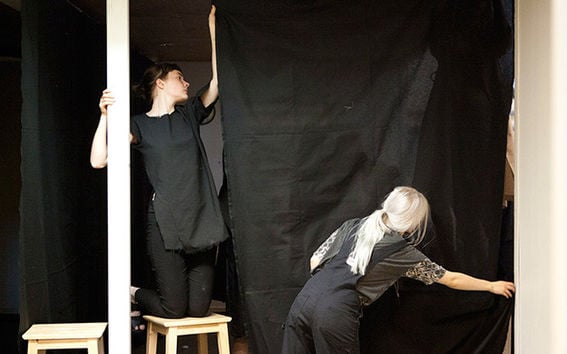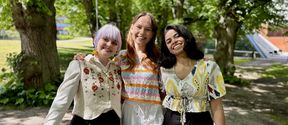Doors open to the fashion market

A shared endeavour
“The lorry is coming!” It's finally here. Some twenty students are waiting to get to work. The show is being constructed on a sweltering May evening in the old boiler hall of the Suvilahti cultural complex.
The load is emptied in no time. Racks full of clothes are rolled inside. The chairs are already in place and the event technology is being fine-tuned. It is yet difficult to believe that the bleak hall will tomorrow transform into a catwalk on which po-faced models will stride to the rhythm of trendy tracks and blinding camera flashes.
The entire spectacle is being constructed as a student effort with students from Bachelor's and Master's arts degree programmes taking part. Some outside input has also been needed in recent times. Susse Roos completed her Master of Arts degree in 2006 and is now in charge of arrangements. All activities in this unfinished hall have the aim of successfully completing next day's dress rehearsal, which will be followed by the show itself.
Inspiration and positive pressure
Antti Peltoniemi, 25, is completing his collection. He's in the workshop of the fashion and clothing design programme sewing the arm seams of a men's jacket by hand and grins. With one week to go before the show, his mind is at ease because he got to work early, unlike last year.
His collection is inspired by the punk and Teddy Boy subcultures that thrived in London as well as the animal patterns, which, according to his background research, they favoured. Peltoniemi decided to focus on this theme, although he was not quite enamoured with it.
“I believe that something new can be created with greater fertility when you go beyond your safe zone. My goal is for someone to still remember my collection weeks after the show is finished.”
For his Bachelor's collection, Peltoniemi wanted to find a new way to make animal patterns for men, for whom they have not been available apart from some old Versace designs.
Sophie Sälekari, 23, is drawing clothing patterns on her desk. She is working on her second collection. The collection she presented at last year's show has been successful at competitions and visible in the fashion media.
Sälekari says a hands-on approach is the only way to strengthen your own identity as a designer. This helps you recognise your strong points and avoid stumbling blocks.
“Last year's collection was a turning point, it introduced self-confidence to my work.”
First and foremost, Sälekari and Peltoniemi hope that their new collections will be received well at the show. Their first collections have done well in competitions, which adds pressure to succeed also in the future.
Sälekari thinks competitions provide good opportunities for networking, marketing and making contacts. Gaining visibility is most important, however.
“It doesn't matter what you do if no-one sees your work. It is not enough to have the appreciation of a small inner circle.”
Collection design and costume art lecturer Tuomas Laitinen says the students are given a free hand to come up with as imaginative creations as they can.
“Our students should have a strong and comprehensive visual message. They must have the confidence to bring their own thing forward and stand out from the crowd. They are also required to reach a certain artistic and skill level.”
Teaching rethink
The ideas and creativity of the students are at the core of teaching. Even wacky student concepts are encouraged. It is often the case that a solid idea may emerge after a student initially experiences failure.
Aalto University's rise to the attention of the international fashion market began eight years ago at the Designers’ Nest competition in Copenhagen. Before this, Aalto students were not always even permitted to participate in international competitions because their standards were not yet considered up to scratch.
The school's reputation has risen like a rocket since then, however. Pirjo Hirvonen, Head of the Department of Design and Professor of Fashion Design, Tuomas Laitinen and other faculty members have modernised teaching practices and other policies over the last decade.
The goal is to bring the process of clothing design as close to the operating practices of industry companies as possible. This is coupled with a humane and creative approach that enables the young designers to discover their own expressive capacity. Teaching has also been concentrated into larger totalities. From this autumn onwards, the academic major totality will be named simply fashion.
An upward spiral and critical mass
Pirjo Hirvonen talks of attaining an upward spiral and a long-term approach to development. One step forward always introduces another, so standards keep on rising. Including top experts – internationally experienced professionals as teachers and sparring partners as well as competent studio and rehearsal supervisors – in the chain is very important. A stable foundation for teaching must be established to create the preconditions for critical mass. Hirvonen says that having individual high achievers is not enough.
Now, critical mass has been achieved.
“We're not aiming to create stars; instead, the focus is on ensuring that our students have strong and versatile competencies and that they know the structure of clothing. Ultimately, the objective is for our graduates to find employment,” Laitinen says.
“Top fashion houses are constantly looking for young designers who are able to identify the essential aspects of the times. Our students are now in demand all over the world,” Hirvonen notes.
The university provides good resources as well as artistic and creative freedom. A key strength is internal cooperation: encounters between experts of different fields create new kinds of synergy and innovation.
Building a continuum
An international fashion seminar was arranged for the second time in conjunction with the show. This is a unique effort by a school of fashion. Thanks to good contacts, the event has managed to attract high-standard speakers, an international audience and media attention.
Cooperation involves the Pre Helsinki platform, which was established by the Ministry for Foreign Affairs, business interests, industry companies and Aalto University alumni. Pre Helsinki arranges the Helsinki Fashion Week and promotes the exporting of Finnish fashion.
The process does not conclude with the spring fashion show. Collections are available to the media at Susse Roos's PR agency Toveri Helsinki. In autumn, the best collections are taken to a showroom in Paris in cooperation with Pre Helsinki.
An understanding of what fashion is all about is beginning to gradually grow in Finland and interest in the industry is rising. Aalto University alumni have made a substantial contribution to this development and a new generation of Aalto graduates is cooperating both amongst themselves and with industry companies and business sector organisations.
The fact that international talent scouts have arrived on the scene is a definitive demonstration of things moving in the right direction.
Photos: Meri Karhu, Mikko Raskinen
The original article has been published in the Aalto University Magazine issue 11. (aalto.fi)
Read more news

Online AI course could boost study equality
Students at the School of Business believe that mastering Artificial Intelligence (AI) can be beneficial for both academic success and career prospects, as AI becomes increasingly integrated into daily life.
2 027 new students admitted to Aalto University’s Finnish, Swedish bachelor’s programmes
13 500 applied to Aalto University in Finland's spring joint application in 2024
Meet the the Program Assistants that elevate the Aalto University Summer School experience for 250 students from all over the world
Each year, the Aalto University Summer School has grown its operations and course curriculum tremendously.